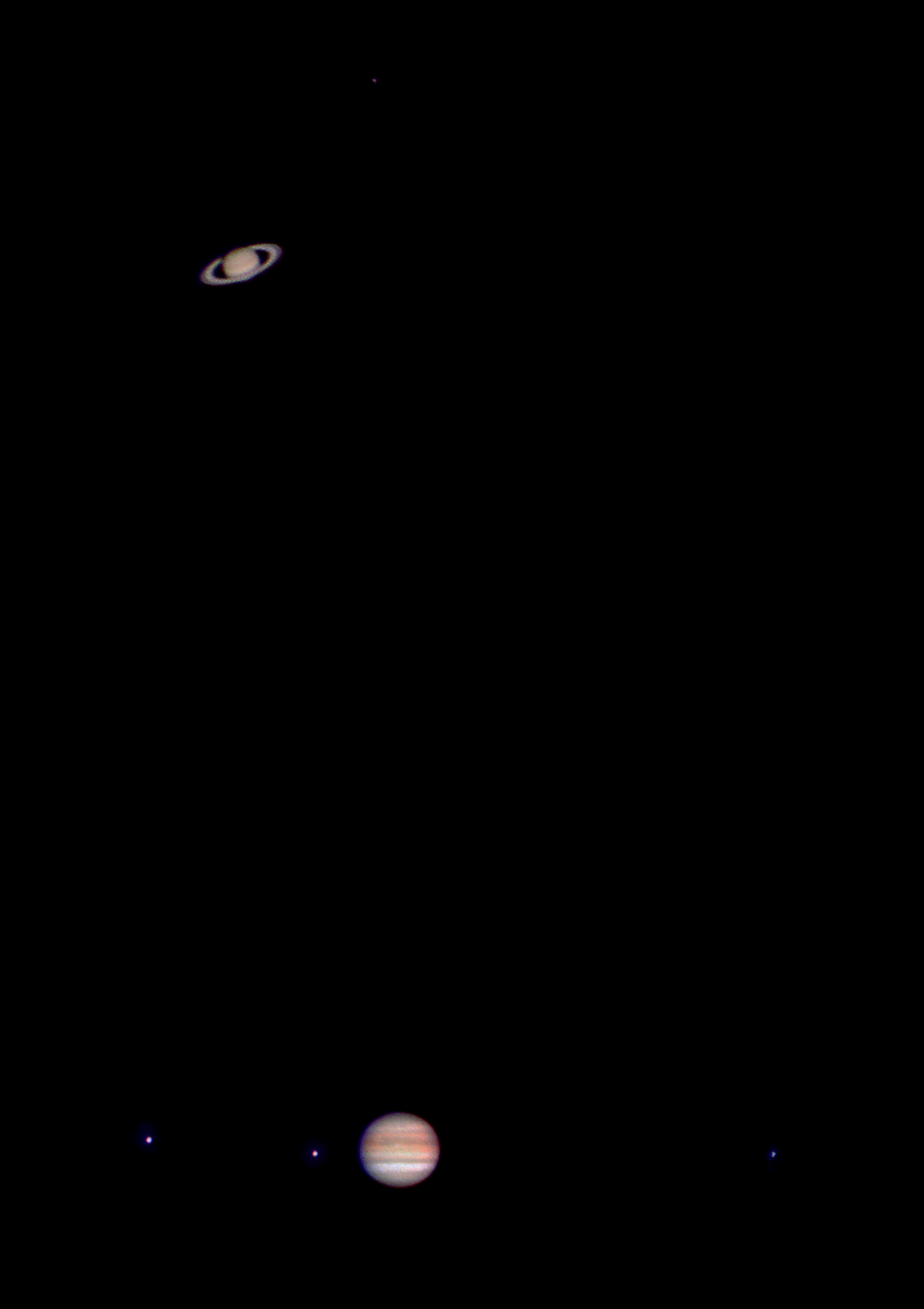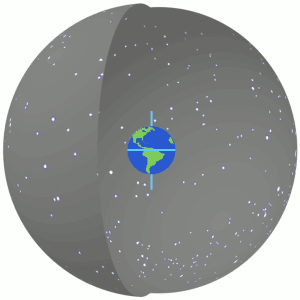|
Triple Conjunction
A triple conjunction is an astronomical event when two planets or a planet and a star appear to meet each other three times during a brief period, either in opposition or at the time of inferior conjunction, if an inferior planet is involved. The visible movement of the planet or the planets in the sky appears therefore normally prograde at the first conjunction, retrograde at the second conjunction, and again prograde at the third conjunction. The lining-up of three planets is a particular case of syzygy. There are three possible cases of triple conjunctions. Between Mercury and Venus At nearly every superior conjunction of Venus (when Venus passes behind the Sun) there is a triple conjunction between Mercury and Venus. In most cases the second conjunction is not visible, because both planets have too small elongation from the Sun. Triple conjunctions between Mercury and Venus are also possible when they are passing between Earth and the Sun at the same time. This ... [...More Info...] [...Related Items...] OR: [Wikipedia] [Google] [Baidu] |
Planet
A planet is a large, Hydrostatic equilibrium, rounded Astronomical object, astronomical body that is generally required to be in orbit around a star, stellar remnant, or brown dwarf, and is not one itself. The Solar System has eight planets by the most restrictive definition of the term: the terrestrial planets Mercury (planet), Mercury, Venus, Earth, and Mars, and the giant planets Jupiter, Saturn, Uranus, and Neptune. The best available theory of planet formation is the nebular hypothesis, which posits that an interstellar cloud collapses out of a nebula to create a young protostar orbited by a protoplanetary disk. Planets grow in this disk by the gradual accumulation of material driven by gravity, a process called accretion (astrophysics), accretion. The word ''planet'' comes from the Greek () . In Classical antiquity, antiquity, this word referred to the Sun, Moon, and five points of light visible to the naked eye that moved across the background of the stars—namely, Me ... [...More Info...] [...Related Items...] OR: [Wikipedia] [Google] [Baidu] |
Uranus
Uranus is the seventh planet from the Sun. It is a gaseous cyan-coloured ice giant. Most of the planet is made of water, ammonia, and methane in a Supercritical fluid, supercritical phase of matter, which astronomy calls "ice" or Volatile (astrogeology), volatiles. Atmosphere of Uranus, The planet's atmosphere has a complex layered cloud structure and has the lowest minimum temperature () of all the Solar System's planets. It has a marked axial tilt of 82.23° with a Retrograde and prograde motion, retrograde rotation period of 17 hours and 14 minutes. This means that in an 84-Earth-year orbital period around the Sun, its poles get around 42 years of continuous sunlight, followed by 42 years of continuous darkness. Uranus has the third-largest diameter and fourth-largest mass among the Solar System's planets. Based on current models, inside its volatile Mantle (geology), mantle layer is a rocky core, and surrounding it is a thick hydrogen and helium atmosphere. Trace amount ... [...More Info...] [...Related Items...] OR: [Wikipedia] [Google] [Baidu] |
Astrometry
Astrometry is a branch of astronomy that involves precise measurements of the positions and movements of stars and other Astronomical object, celestial bodies. It provides the kinematics and physical origin of the Solar System and this galaxy, the Milky Way. History The history of astrometry is linked to the history of star catalogues, which gave astronomers reference points for objects in the sky so they could track their movements. This can be dated back to the ancient Greek astronomer Hipparchus, who around 190 BC used the catalogue of his predecessors Timocharis and Aristillus to discover Earth's precession. In doing so, he also developed the brightness scale still in use today. Hipparchus compiled a catalogue with at least 850 stars and their positions. Hipparchus's successor, Ptolemy, included a catalogue of 1,022 stars in his work the ''Almagest'', giving their location, coordinates, and brightness. In the 10th century, the Iranian astronomer Abd al-Rahman al-Sufi carried ... [...More Info...] [...Related Items...] OR: [Wikipedia] [Google] [Baidu] |
Positional Astronomy
Positional notation, also known as place-value notation, positional numeral system, or simply place value, usually denotes the extension to any base of the Hindu–Arabic numeral system (or decimal system). More generally, a positional system is a numeral system in which the contribution of a digit to the value of a number is the value of the digit multiplied by a factor determined by the position of the digit. In early numeral systems, such as Roman numerals, a digit has only one value: I means one, X means ten and C a hundred (however, the values may be modified when combined). In modern positional systems, such as the decimal system, the position of the digit means that its value must be multiplied by some value: in 555, the three identical symbols represent five hundreds, five tens, and five units, respectively, due to their different positions in the digit string. The Babylonian numeral system, base 60, was the first positional system to be developed, and its influence is ... [...More Info...] [...Related Items...] OR: [Wikipedia] [Google] [Baidu] |
Great Conjunction
A great conjunction is a conjunction of the planets Jupiter and Saturn, when the two planets appear closest together in the sky. Great conjunctions occur approximately every 20 years when Jupiter "overtakes" Saturn in its orbit. They are named "great" for being by far the rarest of the conjunctions between naked-eye planets (i.e. excluding Uranus and Neptune). The spacing between the planets varies from conjunction to conjunction with most events being 0.5 to 1.3 degrees (30 to 78 arcminutes, or 1 to 2.5 times the width of a full moon). Very close conjunctions happen much less frequently (though the maximum of 1.3° is still close by inner planet standards): separations of less than 10 arcminutes have only happened four times since 1200, most recently in 2020. In history Great conjunctions attracted considerable attention in the past as omens. During the late Middle Ages and Renaissance they were a topic broached by the pre-scientific and transitional astronomer-astrolog ... [...More Info...] [...Related Items...] OR: [Wikipedia] [Google] [Baidu] |
Celestial Mechanics
Celestial mechanics is the branch of astronomy that deals with the motions of objects in outer space. Historically, celestial mechanics applies principles of physics (classical mechanics) to astronomical objects, such as stars and planets, to produce ephemeris data. History Modern analytic celestial mechanics started with Isaac Newton's ''Principia'' (1687). The name celestial mechanics is more recent than that. Newton wrote that the field should be called "rational mechanics". The term "dynamics" came in a little later with Gottfried Leibniz, and over a century after Newton, Pierre-Simon Laplace introduced the term ''celestial mechanics''. Prior to Kepler, there was little connection between exact, quantitative prediction of planetary positions, using geometrical or numerical techniques, and contemporary discussions of the physical causes of the planets' motion. Laws of planetary motion Johannes Kepler was the first to closely integrate the predictive geometrical a ... [...More Info...] [...Related Items...] OR: [Wikipedia] [Google] [Baidu] |
Ecliptic Longitude
In astronomy, the ecliptic coordinate system is a celestial coordinate system commonly used for representing the apparent positions, orbits, and pole orientations of Solar System objects. Because most planets (except Mercury) and many small Solar System bodies have orbits with only slight inclinations to the ecliptic, using it as the fundamental plane is convenient. The system's origin can be the center of either the Sun or Earth, its primary direction is towards the March equinox, and it has a right-hand convention. It may be implemented in spherical or rectangular coordinates. Primary direction The celestial equator and the ecliptic are slowly moving due to perturbing forces on the Earth, therefore the orientation of the primary direction, their intersection at the March equinox, is not quite fixed. A slow motion of Earth's axis, precession, causes a slow, continuous turning of the coordinate system westward about the poles of the ecliptic, completing one circuit ... [...More Info...] [...Related Items...] OR: [Wikipedia] [Google] [Baidu] |
Zodiac
The zodiac is a belt-shaped region of the sky that extends approximately 8° north and south celestial latitude of the ecliptic – the apparent path of the Sun across the celestial sphere over the course of the year. Within this zodiac belt appear the Moon and the brightest planets, along their orbital planes. The zodiac is divided along the ecliptic into 12 equal parts, called " signs", each occupying 30° of celestial longitude. These signs roughly correspond to the astronomical constellations with the following modern names: Aries, Taurus, Gemini, Cancer, Leo, Virgo, Libra, Scorpio, Sagittarius, Capricorn, Aquarius, and Pisces. The signs have been used to determine the time of the year by identifying each sign with the days of the year the Sun is in the respective sign. In Western astrology, and formerly astronomy, the time of each sign is associated with different attributes. The zodiacal system and its angular measurement in 360 sexagesimal degree ... [...More Info...] [...Related Items...] OR: [Wikipedia] [Google] [Baidu] |
Star Of Bethlehem
The Star of Bethlehem, or Christmas Star, appears in the nativity of Jesus, nativity story of the Gospel of Matthew Matthew 2, chapter 2 where "wise men from the East" (biblical Magi, Magi) are inspired by the star to travel to Jerusalem. There, they meet King Herod the Great, Herod of Judea, and ask him: Herod calls together his scribes and priests who, quoting Micah 5#Verse 2, a verse from the Book of Micah, interpret it as a prophecy that the Messiah in Judaism, Jewish Messiah would be born in Bethlehem to the south of Jerusalem. Secretly intending to find and kill the Messiah in order to preserve his own kingship, Herod invites the wise men to return to him on their way home. The star leads them to Jesus' Bethlehem birthplace, where they worship him and give him gifts. The wise men are then given a divine warning not to return to Herod, so they return home by a different route. Many Christians believe the star was a miracle, miraculous sign. Some theologians claimed that ... [...More Info...] [...Related Items...] OR: [Wikipedia] [Google] [Baidu] |
Great Conjunction
A great conjunction is a conjunction of the planets Jupiter and Saturn, when the two planets appear closest together in the sky. Great conjunctions occur approximately every 20 years when Jupiter "overtakes" Saturn in its orbit. They are named "great" for being by far the rarest of the conjunctions between naked-eye planets (i.e. excluding Uranus and Neptune). The spacing between the planets varies from conjunction to conjunction with most events being 0.5 to 1.3 degrees (30 to 78 arcminutes, or 1 to 2.5 times the width of a full moon). Very close conjunctions happen much less frequently (though the maximum of 1.3° is still close by inner planet standards): separations of less than 10 arcminutes have only happened four times since 1200, most recently in 2020. In history Great conjunctions attracted considerable attention in the past as omens. During the late Middle Ages and Renaissance they were a topic broached by the pre-scientific and transitional astronomer-astrolog ... [...More Info...] [...Related Items...] OR: [Wikipedia] [Google] [Baidu] |
Right Ascension
Right ascension (abbreviated RA; symbol ) is the angular distance of a particular point measured eastward along the celestial equator from the Sun at the equinox (celestial coordinates), March equinox to the (hour circle of the) point in question above the Earth. When paired with declination, these celestial coordinate system, astronomical coordinates specify the location of a point on the celestial sphere in the equatorial coordinate system. An old term, ''right ascension'' (), "''Ascensio recta'' Solis, stellæ, aut alterius cujusdam signi, est gradus æquatorus cum quo simul exoritur in sphæra recta"; roughly translated, "''Right ascension'' of the Sun, stars, or any other sign, is the degree of the equator that rises together in a right sphere" refers to the ''ascension'', or the point on the celestial equator that rises with any celestial object as seen from Earth's equator, where the celestial equator perpendicular, intersects the horizon at a right angle. It contrasts wi ... [...More Info...] [...Related Items...] OR: [Wikipedia] [Google] [Baidu] |








